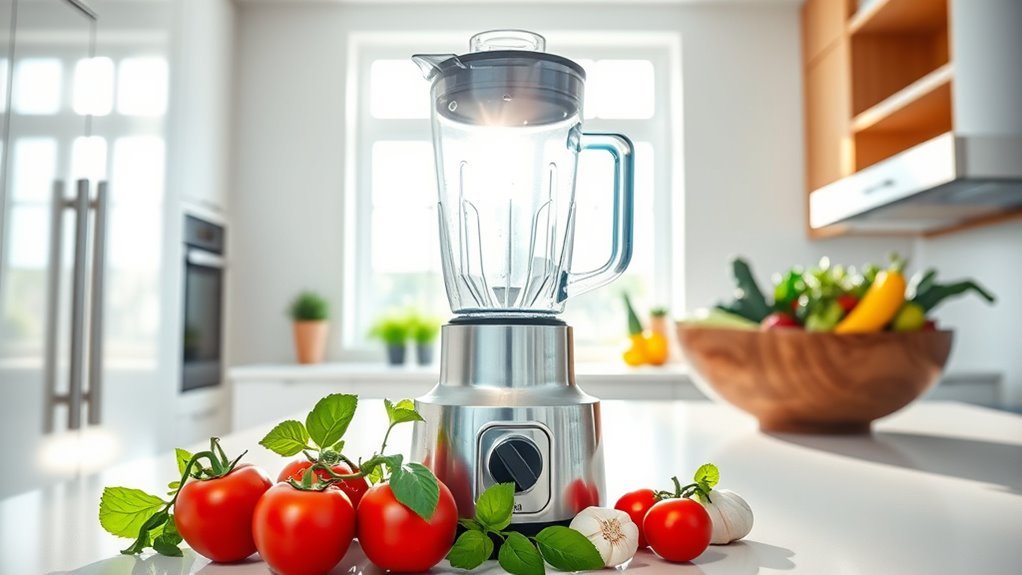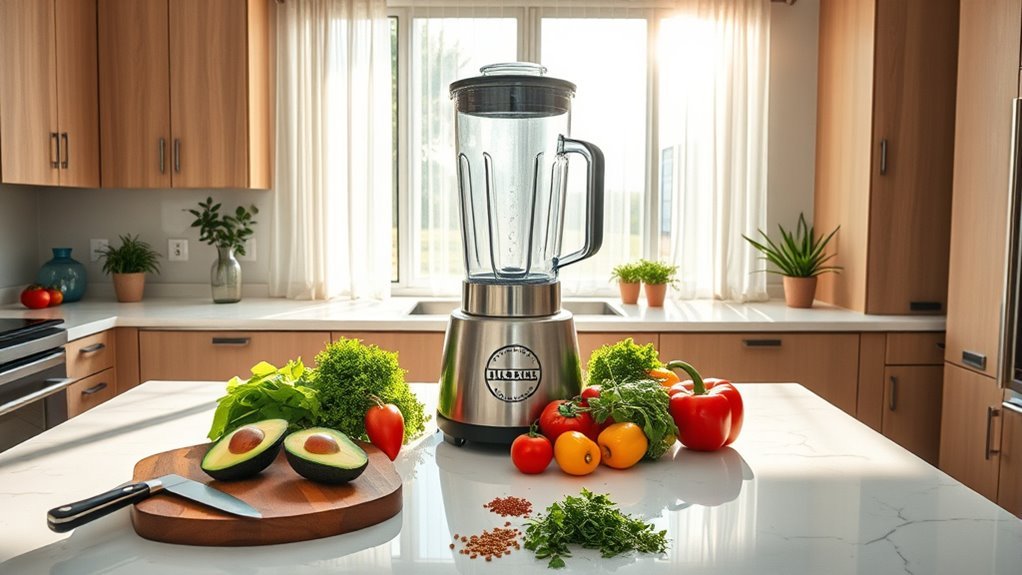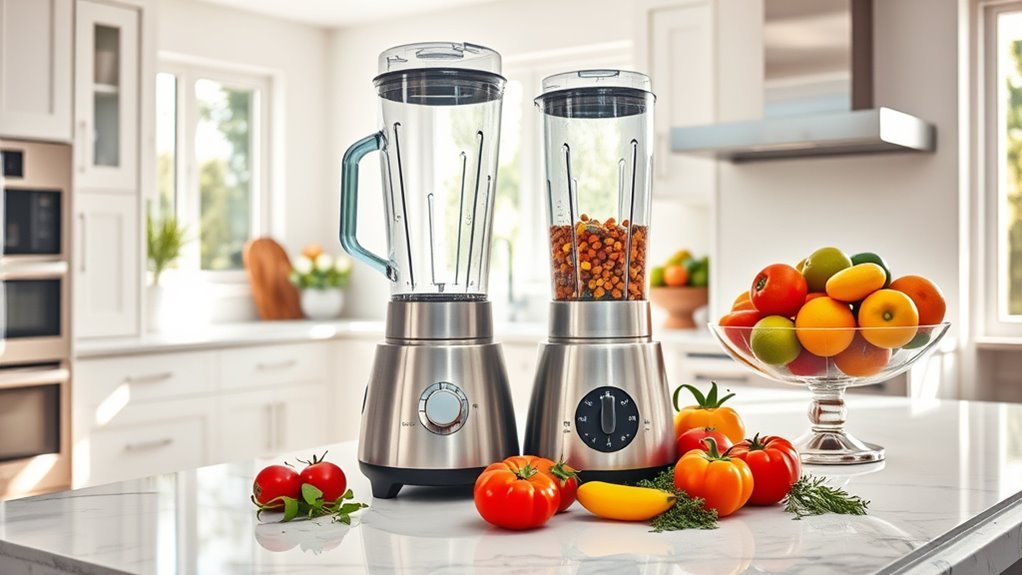To create silky-smooth purées, we’ll start with precise blender settings and proper technique. Fill your high-powered blender only halfway, beginning at low speed before gradually increasing. Process each batch for exactly one minute while using the tamper to guide ingredients into the vortex. Strain immediately through a fine-mesh strainer while hot, and don’t rush the aromatics – they need 20 minutes to develop flavor. Master these fundamentals, and restaurant-quality results await.
Understanding Blender Speed Settings for Soup Making

When it comes to mastering soup preparation, your blender’s speed settings aren’t just random numbers – they’re precision tools for texture control.
Let’s get this right: we’re looking at a strategic blending process that starts low and gradually increases for an even blend.
High-powered blenders tackle tough ingredients like butternut squash with ease, transforming them into silky smooth purées. High-performance blenders offer enhanced versatility, making them ideal for creating a variety of soups and textures.
But here’s the pro move: use the Pulse feature for chunky textures when that’s what you’re after. It’s all about control.
The Art of Batch Blending for Silky Results
To achieve the silkiest possible soup texture, you’ll need to master the art of batch blending – it’s non-negotiable.
We’ll get you there with ruthless efficiency.
Fill your high-powered blender only halfway – that’s your golden rule for safe blending without scalding disasters. Process each batch for exactly one minute to reach that coveted uniform consistency. Trust us, rushing this step leads to chunky regrets.
Want next-level smooth results? Run your blend through a fine-mesh strainer to banish those stubborn fibrous bits. It’s an extra step that separates the good from the extraordinary.
And don’t even think about skipping the final seasoning adjustment – we’re crafting perfection here, not settling for “almost right.” Your creamy texture deserves impeccable flavor to match. Additionally, high-performance blenders can blend tough ingredients effortlessly, making them ideal for creating silky soups.
Essential Equipment and Safety Guidelines

Now that you’ve mastered the art of batch blending, let’s talk proper tools and safety protocols – because we won’t have you turning your kitchen into a hazard zone.
When puréeing soups in your high-performance blender, fill it only halfway to prevent overflow and burns. We’re dealing with hot soups here, folks – let them cool slightly before blending, or you’ll create a steam bomb waiting to explode.
Use that tamper to guide ingredients into the blending vortex for silky results. Keep each batch under one minute to protect your motor.
And please, gear up properly. Oven mitts aren’t optional when handling scalding liquids, and an apron’s your first defense against splatters.
Whether you’re using immersion blenders or countertop models, these safety guidelines aren’t suggestions – they’re non-negotiable rules for keeping you intact.
Mastering Aromatics and Base Ingredients
Since we’ve covered safety, let’s immerse ourselves in the real magic – those essential aromatics that’ll make or break your soup.
We’re talking 300 grams of vegetable power here: onions, garlic, leeks, and celery.
Start by slowly sweating them in 30-40 grams of butter for 20 minutes before adding liquid ingredients. This vital step develops that perfect blend of natural sweetness we’re after.
Trust us – your blender’s powerful motors won’t compensate for rushed aromatics.
Season by season, we’ll adapt our base. Spring calls for asparagus, fall demands butternut squash.
Whatever your choice, remember these blender tips: herbs and spices go in after sweating aromatics.
Want to make killer vegetable soup? Master this foundation first. The aromatics are where precision meets perfection.
Straining Techniques for Professional-Grade Texture

While your blender’s done its job, we’re not settling for merely smooth – we’re aiming for silk.
Let’s elevate your blending system to achieve that professional-grade texture through strategic straining.
Here’s your battle plan for minimal food waste and maximum luxury:
- Fill your high-powered blenders only halfway – overfilling kills consistency
- Deploy your tamper aggressively to force solid ingredients into the vortex
- Strain soup immediately after blending while it’s hot – cold straining’s a nightmare
- Consider a quick immersion blender pass before final straining if needed
A fine-mesh strainer is your secret weapon for that creamy consistency you’re craving.
Press through methodically, and watch those unwanted fibers vanish.
The result? A consistency purée that’ll make restaurant chefs jealous.
Frequently Asked Questions
How Do I Make My Soup Completely Smooth?
We’ll blend soup in small batches with a high-powered blender, strain through a fine mesh sieve, and adjust liquid content. Don’t forget to sweat aromatics first and control temperature.
How Do I Make My Soup More Creamy?
Let’s enrich our soup’s creamy texture with heavy cream, coconut milk, or dairy alternatives. While blending, gradually add thickening agents like potato or cashews, then finish with flavor enhancers.
What Makes Soup Silky?
We’ll achieve silky soup through proper texture enhancement: sweating aromatics, selecting quality ingredients, using a high-powered blender, straining through fine mesh, and balancing flavors with the right amount of liquid.
How to Make Vegetable Soup Smooth?
We’ll create the world’s silkiest soup by choosing tender vegetables, cooking them fully, blending in batches with hot broth, straining through mesh, and finishing with careful seasoning adjustments.

